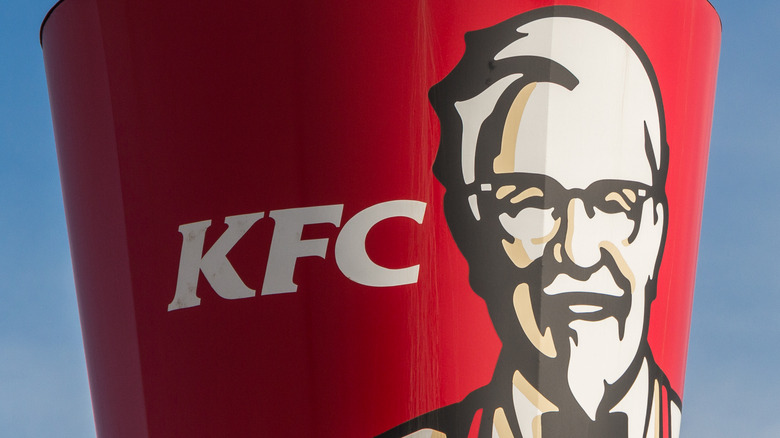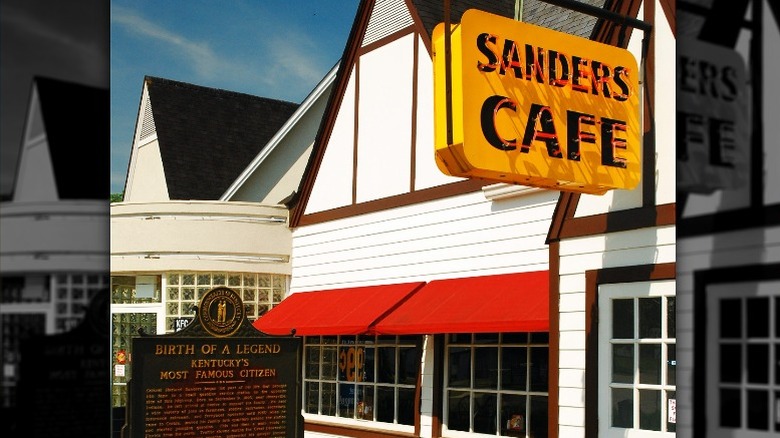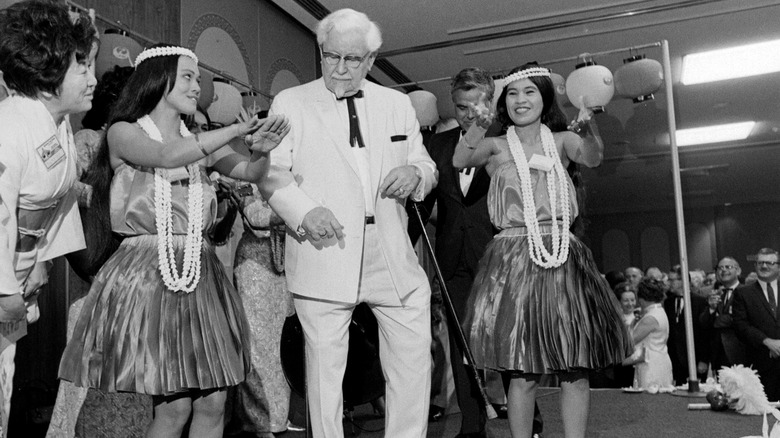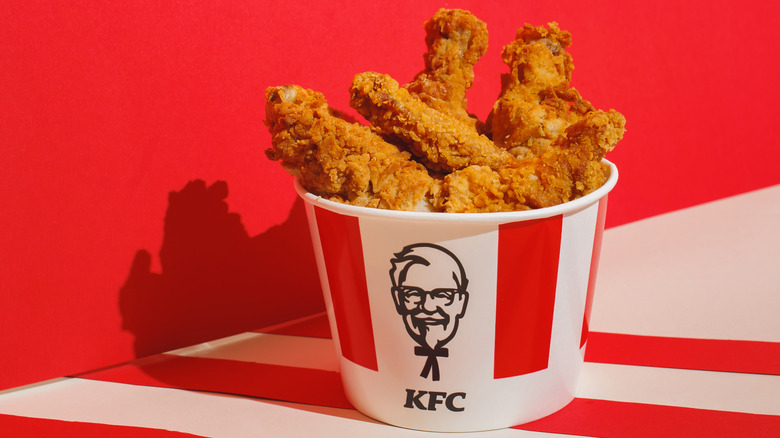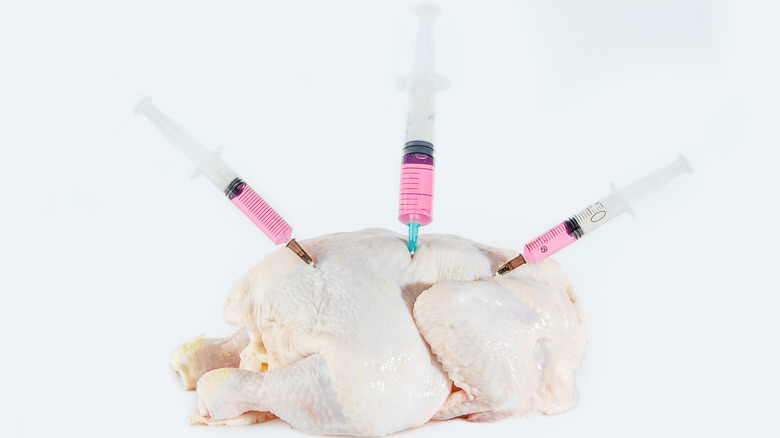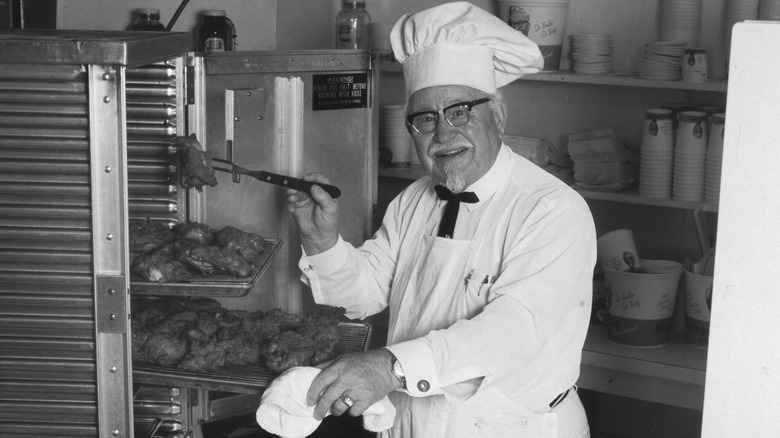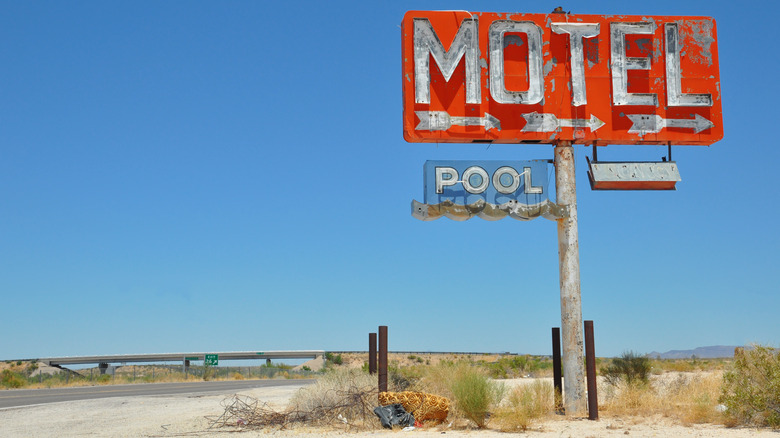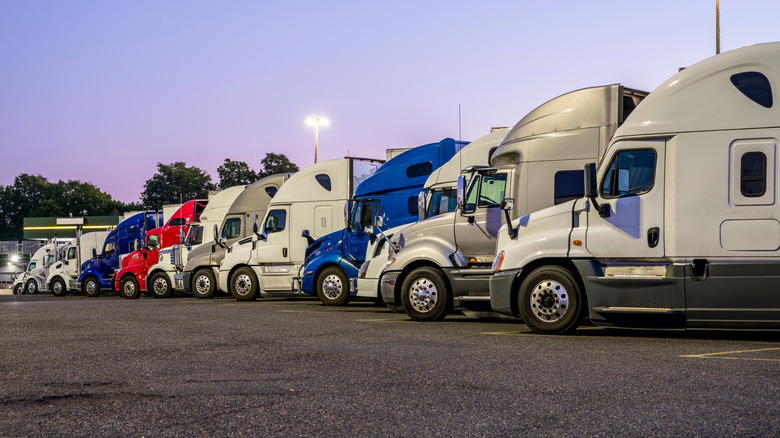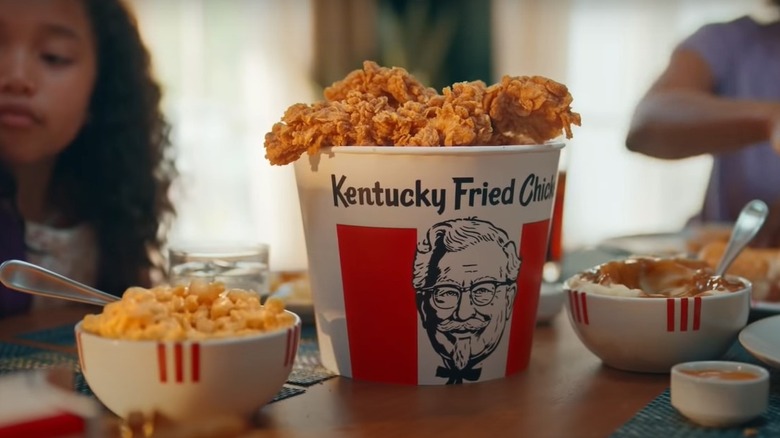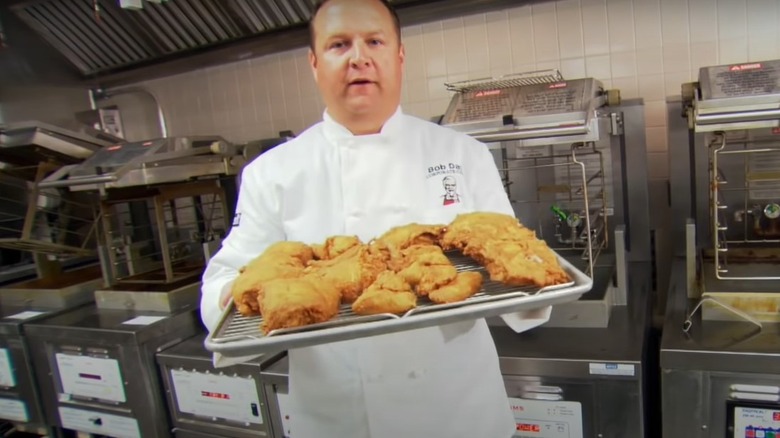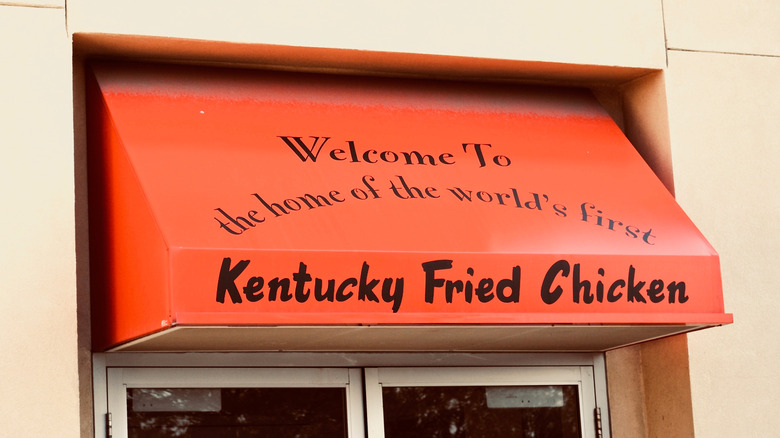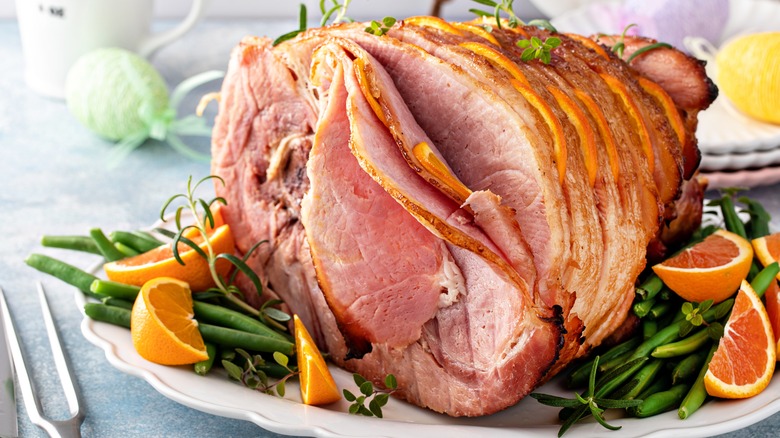What It Was Really Like To Eat At The First KFC
Few foods are as phenomenal as fried chicken. Virtually nothing compares to a fresh piece of crispety, crunchety, slightly greasy chicken that's been battered and deep-fried to perfection. To say it's in a culinary class by itself isn't hyperbolic — it's a bonafide fact of life. Luckily, thanks to a certain Kentucky colonel named Harland Sanders — who was, technically, a "colonel" (via History) — fried chicken spots are now a dime a dozen, with more than 10,000 chicken-focused restaurants operating in the U.S. as of 2020.
Yet even with countless imitators springing up in its wake, nothing truly matches the finger-lickin' greatness offered by Kentucky Fried Chicken. An American institution since Colonel Sanders first donned his trademark white suit more than seven decades ago, KFC has been delighting diners since its inception with its variety of always-reliable, southern-style offerings.
Of course, not unlike a popular television series that evolves beyond its initial pilot, the experience of enjoying KFC in 2022 is drastically different from those patrons of the original KFC restaurant, located in Corbin, Kentucky. The location, where Colonel Sanders toyed in the kitchen as he developed the chain's famed 11 herbs and spices, still exists as a museum and modern-style KFC.
But current customers aren't exactly enjoying the same service as those from the original location back in the 1930s and 1940s. So let's pack up the car, head towards U.S. Highway 25 in Kentucky, and discover what it was really like to eat at the first KFC.
It was called Sanders Cafe
The process of large companies renaming themselves is nothing new. Whatever the reason or rationale, it's commonplace for companies to begin under one name before rebranding as something entirely different over time. Kentucky Fried Chicken is no exception in this regard, as diners at the first KFC weren't eating at KFC at all — they were eating at Sanders Cafe.
Part of the reason for this simple original name may be that Sanders didn't initially envision his small, roadside restaurant blossoming into an international juggernaut. Not to say he wasn't ambitious or driven, because of course he was. After all, it takes a particular type of determination for a person to reach the level of fame and fortune attained by Colonel Sanders during his life. But it's hard to imagine anyone, even the man himself, would have predicted that, by 2022, the company would end up with more than 24,000 locations worldwide.
Sanders Cafe still operates as a museum and restaurant in Corbin, Kentucky. Though, while the sign remains out front as a historical artifact, modern diners aren't eating at Sanders Cafe anymore — they now eat at a standard, appropriately-named KFC.
Colonel Sanders himself may have served you
Before he was an internationally beloved superstar — or a caricature who'd be portrayed by countless actors and actresses in commercials through the years — Colonel Sanders was simply a 40-year-old small business owner with little more than a desire to feed hungry people. After all, according to Southern Living, before moving into the original (eventually burned-down) location in 1937, Sanders actually began his restaurant by serving patrons at his own dining room table. Given this, it can't be shocking to learn that if you ate at the first KFC — as in the restaurant, not the man's kitchen — you may have been served by the colonel himself.
As a man who "had two rules ... do all you can and do it the best you can" (via Sanders Cafe), it's only logical that the hard-working Sanders was a constant presence at his Corbin, Kentucky location. This meant the odds of being served by him during your visit, or at least spotting the man while on site, were fairly high.
Colonel Sanders retained a hands-on approach throughout his life, even after selling the company in 1964. In fact, according to Roadside America, up until his death in 1980, the colonel would randomly arrive at KFC locations around the U.S. and personally inspect their products.
You could only order Original Recipe
Though the KFC menu isn't necessarily overloaded with options, it does contain a fair variety of chicken choices for those interested in something beyond a standard eight-piece bucket. Various versions of chicken are offered to customers in 2022, including (but not limited to) bone-in chicken, boneless tenders, and pot pies. But this wasn't the case for folks who ate at the first KFC, as the only available fried chicken option back then was what's now-known as Original Recipe (hence the name).
While the question "Original or Extra Crispy" is now expected when we order KFC, there was, perhaps unsurprisingly, no such thing as Original Recipe at the first KFC — it was simply the recipe. In fact, it wasn't until decades later, in 1972, that the restaurant first offered the Extra Crispy version to consumers (via The New Yorker).
Frankly, since no one in their right mind would ever choose Original over Extra Crispy, it's sort of sad to consider the singular option provided to back-in-the-day diners. Then again, no one seemed to mind this lack of options as KFC's popularity boomed, so perhaps we should withhold any sympathy.
You may have eaten at a gas station
While a lucky few are born into fantastically wealthy families — provided with literally foolproof financial safety nets (and perhaps, "a small loan") — many other individuals begin their journey towards personal and professional success under less auspicious circumstances. The latter is certainly true of Colonel Sanders, whose initial restaurant didn't have any sort of fancy quarters. It served guests at his gas station along U.S. Highway 25 (via Smithsonian Magazine).
With the implementation of the Interstate Highway System by President Eisenhower still nearly two decades away (via the Federal Highway Administration), full service rest stops and travel centers on major highways — or major highways, at all, for that matter — didn't exist yet in 1937. At that time, small filling stations (like the one owned by Sanders) were the only places for travelers to stop for service and fuel during long-distance trips.
So, having learned how to cook for his family as the child of a single mother (via City of Corbin), Sanders decided he should offer more than gas and oil at his business — and it's safe to say he made the right decision.
There was no confusion whether it served real chicken
Most conspiracy theories exist and endure because they contain some sliver of believability. Whether that strand of seeming truth actually is true doesn't necessarily matter, because if it contains the illusion of reality, it's likely to run amok among the public's imagination. Not that this has anything to do with the undoubtedly accurate rumor that's dogged KFC for decades: that it changed its name in 1991 because it no longer served actual, authentic chicken.
In other words, if you ate at the first KFC, you were able to eat real, unadulterated chicken — unlike today.
Just kidding! In fact, the bizarre, over-the-top rumor that KFC's products can't legally be classified as chicken due to genetic modifications has been thoroughly debunked through the years (via Snopes). What exactly spurred someone to accuse KFC of serving mutant poultry is unknown. But if nothing else, no one harbored any of these reservations when eating at the first KFC — nor did diners need the University of New Hampshire to declare any such rumors to be "a hoax."
It was one of the only places to get fried chicken
Imagining the world before you were born, or genuinely grasping the subtle (and massive) differences that paint one time period versus another, is tricky. After all, it can be a challenge remembering eight days ago, let alone eight decades into the past. So while it may be hard to wrap your head around the idea that fried chicken wasn't always so ubiquitous, with any number of chains ranging from Popeyes to Wingstop available in 2022 — many literally at our fingertips — the truth is when Colonel Sanders first prepared his famed poultry product, fried chicken was a bit of a rarity.
Now, while fried chicken traces its history back to the 18th century (via the BBC), it wasn't considered a common everyday meal or food item before KFC began mass-marketing the product. To be sure, it was widely beloved prior to Colonel Sanders' decision to open his restaurant at the tail end of the Great Depression. But the monumental amount of work involved in preparing and cooking fried chicken, particularly with the antiquated culinary techniques and tools historically available, made it something to enjoy during celebrations and gatherings, and not an everyday option.
Given its popular-yet-elusive availability, it's no wonder people began flocking to the Sanders Cafe to try the perfectly-seasoned and succulent item – both before the restaurant burned down in 1939, and after it was rebuilt in 1940 (via Southern Living).
You could spend the night at an adjoining motel
In 2022, long-distance road trips aren't terribly daunting endeavors. But back when Colonel Sanders first decided to prepare and serve food for hungry passersby, the dining and lodging options in rural Kentucky were slim to none. So when tragedy struck and his first restaurant burned down in 1939, Colonel Sanders chose to up the appeal for travelers, adding a motel room when rebuilding the property (via Kentucky Tourism).
Somewhat similar to a bed and breakfast in its intimate setup, the motel room at the first KFC was literally just a motel room — not any sort of sprawling enterprise. There were no modern-day amenities or accommodations as we'd expect from a hotel stay in our current world, but that didn't matter. As a tool to drum up further business, it did the trick exactly as intended.
For anyone curious about the KFC-adjacent motel, you can take a look for yourself, as the Sanders Cafe and Museum contains an accurate model of the motel room for visitors to check out (via City of Corbin).
It was devised as a rest stop for weary travelers
Colonel Sanders was intimately familiar with the challenges facing the average road-tripper in the 1930s. After all, having interacted with countless travelers as the owner of his service station on U.S. Highway 25 in Corbin, Kentucky, he'd heard firsthand how displeased drivers were with the lacking locations for a decent meal. So, as a fairly-seasoned chef who'd been preparing meals for his own family since he was a boy (according to the City of Corbin), Sanders started offering his home cooking at the station.
Armed with the thought he "couldn't do worse than ... people running these places around town," as he was quoted saying in his biography, "The Colonel" (via Smithsonian Magazine), Colonel Sanders decided to cook for his customers. The digs weren't fancy at first, and consisted of Sanders' own dining room table that was brought to the station for diners.
Whether Colonel Sanders envisioned this decision leading to his culinary breakthrough is unclear, but the gambit to increase business — and satisfy hangry customers — was a monumental success. Traffic at his station increased, and before long, the first KFC required expansion beyond a single table at a gas station.
Food was served family-style rather than individually
Actually, in some ways, the notion of being served family-style — as in having a table share large servings of food, rather than each person ordering individual meals — hasn't changed from the first KFC. With at least eight different family bucket combo meals available for purchase on its menu in 2022, you can still order and enjoy a dinner from KFC while theoretically being served family-style. But while the modern KFC menu also has countless individualized offerings, diners of the first KFC ate family-style meals almost exclusively (via Smithsonian Magazine).
When you think about it, this may have been the only logical way Colonel Sanders could have gone about it, at least initially. For one thing, the food preparation and cooking methods of the day presented a barrier to taking orders, as well as preparing specific mealsfor each person. Additionally, since food preservation was less evolved than in the 21st century — and there was no guarantee how many guests would stop to eat at the first KFC — Sanders was beholden to what was available.
Clearly, though, no one was complaining, and the Colonel's finger-lickin' offerings, whether eaten family-style or solo, remained a hit with everyone who stopped there.
Colonel Sanders patented a pioneering chicken cooking process
Colonel Sanders didn't invent fried chicken — which, believe it or not, wasn't even originally created in the United States at all (via the BBC). But the man in a white suit doesn't need more credit than he's due, because while he may not have been the first person to conceive of fried chicken as a food, he was responsible for dramatically simplifying the cooking process through the use of a pressure fryer, according to Sanders Cafe.
If you've ever made fried chicken at home (particularly if you've cooked it on the stove with nothing more than a pot of hot oil), you're likely aware of how painstaking and time-consuming it can be. The laborious process almost certainly contributed to the lack of consistent, widely available fried chicken restaurants before KFC's arrival. But once Colonel Sanders patented the cooking technique involving a pressure cooker, it both simplified and quickened the cooking process, laying the path for mass production of perfectly produced fried chicken throughout the world.
Frankly, Colonel Sanders' relationship to fried chicken is akin to that of Taco Bell founder Glen Bell's relationship to the crunchy taco. Neither man invented their trademark food, but without each one's innovation, who knows what the world of fried chicken or tacos would look like.
The restaurant didn't serve 'Kentucky' fried chicken
Did you ever wonder why it's called Kentucky fried chicken rather than just, say, fried chicken? Some may have presumed it was one of the many brilliant marketing ideas spearheaded by Colonel Sanders, but the state-specific name didn't develop at the first KFC. It was actually the brainchild of Utah-based restaurateur Pete Harman and his sign-painter Don Anderson (via Deseret News).
Actually, the now-internationally famous name was conceived on somewhat of a whim. After Colonel Sanders prepared his secret fried chicken recipe for his friend and fellow restaurant owner, Harman decided to add the pressure cooked product, with its famous 11 herbs and spices, to his menu. Yet unsure how to advertise the item, Anderson suggested the simplest path. "How about Kentucky Fried Chicken?" Anderson tossed to Harman as an idea, since Sanders was "from Kentucky and it's fried chicken."
Soon, Harman became the first KFC franchise-owner, partnering with Sanders to bring the simplified, simply delicious product to the masses (via Smithsonian Magazine). The two remained friends throughout the remainder of their lives, and in 2012, Harman, at the age of 90, still owned and operated more than 300 KFC restaurants throughout the southwestern U.S.
You could order protein-rich foods other than chicken
It's no surprise that uber-successful companies often develop an itch to stretch their wings and expand their market share beyond those signature products. KFC is no different, which at one point went so far as to introduce "Colonel Sanders' Country Style BBQ Ribs" in 1975 (via The New Yorker) — a product that clearly didn't stand the test of time. But while Kentucky Fried Chicken eventually chose to solely embrace what it does best in fried chicken, the first KFC actually offered other proteins to famished customers as well.
Not that they had much of a choice, necessarily. After all, Colonel Sanders' menu in the early days likely consisted of whatever meal he was able to prepare that day, whether it was chicken, beef, or ham.
Though none of the non-fried chicken options were responsible for Sanders Cafe evolving into KFC, it's not surprising that, given the cook, everything besides chicken was still delectable. As Duncan Hines — yes, the same one from the famous cake mix brand — wrote in his book "Adventures in Good Cooking," the first KFC was "a very good place to stop," noting its "sizzling steaks ... (and) country ham" were worthy orders alongside its famed fried chicken.
